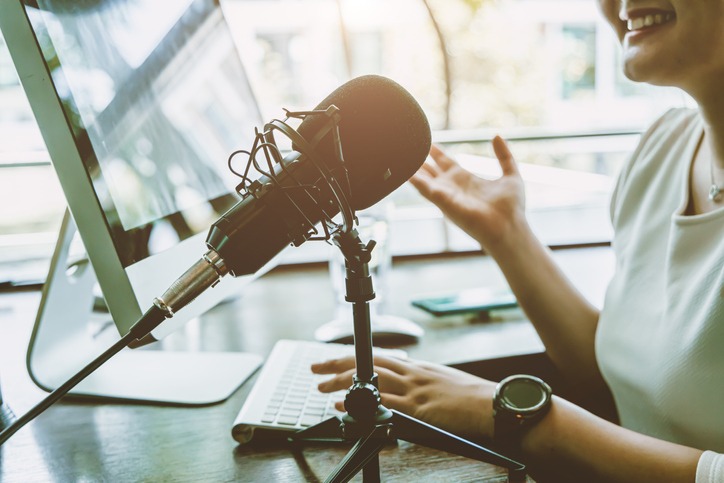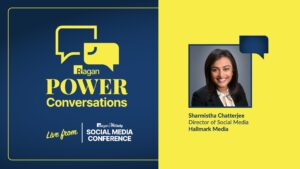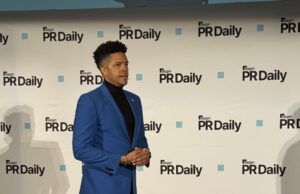How communicators use podcasts to have conversations about thought leadership
Nicole Christie, senior writer and producer at Microsoft, weighs in on the trend of corporate thought leadership podcasts ahead of Ragan’s Social Media Conference.

In the last year, the focus has shifted from a perfectly-worded press release to making space for important conversations.
The more successful organizations are leaning into these opportunities by creating fresh, innovative thought leadership content using tools such as live audio rooms and podcasts to dissolve the distance of our digitally distanced world.
Ahead of her session at Ragan’s Social Media Conference at Walt Disney World on Sept. 9, we caught up with Nicole Christie, senior writer and producer at Microsoft, to learn how her company has used podcasts to share its brand values with employees and consumers alike—no matter where they might live.
Ragan: What’s one thing in your morning routine that sets you up for success for the day ahead?
Christie: While I’m a relatively early riser, it’s not peak cognitive time for me, so trying to wake up and get going on anything that requires brainpower or creativity doesn’t work. Instead, I block two hours in the morning just for myself—to have coffee and breakfast, talk with my husband, meditate, exercise and get things in order for the day.
I don’t have children, so I realize that amount of time isn’t available to many people, but the key for me is literally putting myself first every day and also being able to ease into the day with a calm and present mind, which suits my highly-sensitive, introverted temperament.
Ragan: If you had one word to describe your role, what would it be?
Christie: Storyteller.
Ragan: What are you most looking forward to about joining Ragan in person at Disney World?
Christie: Meeting new people without a screen in the way! While I’ve worked remotely for 15 years and am very comfortable doing so, the pandemic helped me realize just how important energy and nonverbal communication are to connecting with people, especially someone you’ve just met and when you’re learning together. I’m so glad to be able experience that this year in Orlando!
Ragan: What element of your podcasting/storytelling strategy at Microsoft do you consider your biggest win?
Christie: Over the last seven years, we’ve been transforming our culture at Microsoft, and the role of the manager is a key factor in that.
Our 21,000 managers have completed nearly 50 hours of training to learn to lead in new ways. The “Managers 1:1” podcast brings that to life through conversations where managers share where they’ve made mistakes, where they’ve succeeded, what they’ve learned and what challenges they encounter as people managers. It’s a wonderful, human way to help managers learn from each other—and it’s been so critical during the pandemic when they couldn’t be in the same room together or have a conversation over coffee and feel understood.
The podcast is available to all employees and we’ve also heard it helped new hires learn about our culture and feel more connected to Microsoft as they onboarded virtually—that’s been a huge (and very unexpected) win!
Ragan: What’s the biggest change you’ve seen with the adoption of new approaches to podcasting, storytelling and thought leadership the past year and a half? What new techniques and approaches will stick with you after the pandemic has subsided?
Christie: The sheer uptick in corporate podcasts—both internal and external—has been extraordinary. While the medium has been popular from its inception as a way for people to immerse themselves in personal topics of interest, hobbies, stories, etc., it’s incredible to see businesses recognize that this is a way to bring their culture to life for employees and candidates—and bring their brand to life for customers.
I’ve seen more warm, candid conversations and pure storytelling—the kind that follows a narrative arc—that feels less like reporting or advertising or branded content, and more like sitting around a campfire or the dining room table after dinner. This really resonates with people, and I hope we see more of it as the pandemic subsides.
It’s also important to keep in mind that while we listen to podcasts on our devices, unlike blogs and social media, podcasts give us a break from screens. Our eyeballs and thumbs can take a rest while we simply listen—in the car, on a run, at the beach. Most of us were read to as children—by our parents, teachers, and other caregivers—so there’s also great comfort in audio storytelling. We can listen together, on road trips or while preparing a meal, which takes us out of the isolated world of our phones and laptops, driving conversations and connection.
There’s a very “old-time radio” quality about podcasts that I love. It’s a throwback to the earliest days of broadcast media, which is refreshing in our modern, always-on, constantly task-switching world.
Hear more from Nicole Christie during Ragan’s Social Media Conference, Sept. 9 at Walt Disney World. Learn more and register here.







